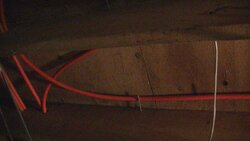Hello everyone I am about to retrofit radiant floor underneath 3/4" subfloor with 1/2" PEX AL PEX. mixed floor coverings on 1st floor...
Joists are 16" on center and I will run 2 pipes in each bay 6-8 inches apart.
My current system is baseboard hotwater... cheap baseboards and my entire system is undersized it had never really kept the house warm (When it was oil fired) on single digit days. so we got a wood stove and then later indoor wood boiler in series with oil & 1000 gal tank
So my retrofit is add on
I want to improve efficiency of system (inexpensively) and lower water temps to get more out of my 1000 gals of storage because I dont really get any heat from baseboards when the temp is under 160.
I am hoping the warm floor is going to change all that!
So here I am, about to pull pipe through the holes that I have drilled for 4 zones 225' - 250' each from where the manifold will be,
I am thinking about plates and floor mass. i know that tile, wood & carpet all will effect temps and response times. If i were to add more mass, say extra plates or foil covered sheet rock in between the pex runs(as a spacer) then maybe even foil then sheetrock over that. or how about even using aluminum foil and covering the joists?
Are these ideas stupid?
Am I crazy or would more mass be better?
Joists are 16" on center and I will run 2 pipes in each bay 6-8 inches apart.
My current system is baseboard hotwater... cheap baseboards and my entire system is undersized it had never really kept the house warm (When it was oil fired) on single digit days. so we got a wood stove and then later indoor wood boiler in series with oil & 1000 gal tank
So my retrofit is add on
I want to improve efficiency of system (inexpensively) and lower water temps to get more out of my 1000 gals of storage because I dont really get any heat from baseboards when the temp is under 160.
I am hoping the warm floor is going to change all that!
So here I am, about to pull pipe through the holes that I have drilled for 4 zones 225' - 250' each from where the manifold will be,
I am thinking about plates and floor mass. i know that tile, wood & carpet all will effect temps and response times. If i were to add more mass, say extra plates or foil covered sheet rock in between the pex runs(as a spacer) then maybe even foil then sheetrock over that. or how about even using aluminum foil and covering the joists?
Are these ideas stupid?
Am I crazy or would more mass be better?


